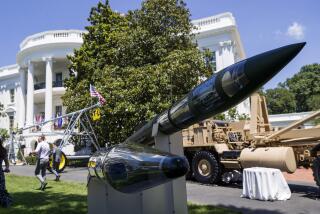Missile Plan Faces Obstacles
- Share via
WASHINGTON — If there is one thing on which missile defense advocates and critics agree, it’s that the technology isn’t ready yet. Where they differ is on whether the technology will be “ready enough” three years from now to meet President Bush’s accelerated deployment plan announced last week.
Even under the Pentagon’s best-case scenario, the missile defense system expected to be fielded by the end of 2005 will be able to shoot down no more than 20 incoming enemy rockets before all available interceptor missiles are spent. And that assumes jury-rigged radars function flawlessly, the weather is cooperative, half-tested missiles don’t err and the enemy doesn’t use decoys or other tricks.
That’s a far cry from Ronald Reagan’s dream of a missile defense “astrodome” protecting the United States, but defense officials are optimistic.
“We think that this modest and initial capability is both warranted, but will also be very, very useful,” J. D. Crouch, assistant secretary of Defense for international security, said when plans were unveiled last week.
Bush’s order to field the missile defense system in the next three years forces what has been a developmental program to suddenly -- some say prematurely -- become a deployment program, skipping an entire phase of testing.
Traditionally, new weapon systems go through two phases of testing: developmental, in which technology is tested piece by piece under controlled conditions; and operational, in which the pieces are put together and tried out in the real world.
So far, the ground-based interceptors at the center of the missile defense system have undergone only eight of at least 19 planned developmental tests. Of those, five were successful.
Pentagon officials say five out of eight is good for a weapon system at this stage of development. Critics say it’s not good enough to skip the operational phase and move directly to deployment.
“Normally, you don’t deploy until you’re done with developmental testing and operational testing,” said Lisbeth Gronlund of the Union of Concerned Scientists. She contended that the Pentagon is setting aside its ordinary standards to rush the missile defense system’s deployment: “If this were a tank or a gun, you couldn’t do this.”
The technological challenges facing the program are daunting. Pentagon officials say the best way to learn is by doing. Critics counter that expensive mistakes will draw money and energy from more practical steps that would provide more security. (The Pentagon has secured $16 billion over the next two years to fund the missile defense system and is seeking an addition $1.5 billion.)
Fears Over Delay
Even some missile defense proponents worry that speeding deployment of a flawed, rudimentary missile defense program could delay development of a better, more reliable system.
“Rather than developing the kind of system that might work, there’s a risk we will get discouraged by a system that doesn’t work and decide to call the whole thing off,” said John Isaacs, president of the Council for a Livable World, which opposes the deployment.
Even supporters admit that deployment within three years will be a challenge. In some ways, it is even more ambitious than the 1960s space race. Instead of trying to get one rocket to the moon, the system will have to have many rockets and missiles and radars -- most still under development -- all working well and in concert. If the system fails, it won’t be a crew dying; it could be thousands, even millions, of people.
“There is less margin of error here,” Isaacs said.
To meet Bush’s timetable, the Pentagon will have to speed development of new equipment, and jury-rig other systems.
There are three main parts to a ground-based missile defense system. The first is interceptor missiles, which home in on a target to destroy it. The second is booster rockets, to put the interceptor missiles into the atmosphere. The third is radars and other sensors, to detect and track an enemy missile through its trajectory.
The most developed technology is the interceptors, which are equipped with radars that help them hit and destroy the target. Pentagon planners refer to the technology as a “bullet hitting a bullet,” and most of the tests to date have focused on making that work.
During a Pentagon briefing last week, missile defense agency director Lt. Gen. Ronald Kadish showed impressive footage of interceptor tests, with missiles streaming through the air, adjusting their trajectories and striking the target with a puff of smoke and debris.
But critics point out that the tests are highly scripted, and nonetheless have been successful only five out of eight tries.
“That statistic is misleading because the tests have been a bit artificial,” said James Lindsay, a missile defense expert at the Brookings Institution, a nonpartisan Washington think tank.
More troublesome, experts say, are the other two pieces of the technology: the boosters and the radars.
So far, the Pentagon has not developed a booster rocket that can carry the missile into the atmosphere fast enough. The tests have been conducted on modified Minuteman missiles, but they are too slow for anything except tests. After a booster rocket tested earlier this year failed, the Pentagon began developing a second, parallel rocket, in case the kinks in the first can’t be fixed in time.
“I don’t like where we are in terms of being developed with the boosters. That is a fact. Everybody knows that,” Kadish acknowledged to reporters this week. He vowed to make progress on the problem in the coming year: “Calendar year ’03 is the year of the ground-based booster.”
Perhaps the thorniest challenge will be piecing together a radar and sensor system that will be able to identify and track incoming missiles and allow military officers to figure out which interceptors to use and where to send them.
Ideally, the Pentagon wants to put in place a ground-based radar system known as “X-band,” a low-wavelength radar sensitive enough to distinguish decoy missiles from warheads. It also wants to deploy a space-based infrared system, known as “SBIR-high,” to replace the existing and aging early-warning satellite system. And it wants to add lower-orbit infrared sensor satellites, known as “SBIR-low,” to improve the system’s tracking ability.
These systems are under development but are years away from deployment. So, to support the early missile defense deployment, the Pentagon plans to upgrade and employ existing radar systems.
First, the military plans to upgrade a Cold War-era radar on Shemya Island in the far western Aleutian Islands of Alaska, called the Cobra-Dane radar. Lt. Col. Rick Leonard, spokesman for the missile defense agency, said new computers and software will be installed so the radar system can handle the volume of lightning-fast calculations needed for a missile defense system.
In addition, the United States has asked Great Britain and Denmark for permission to upgrade similar radars on their territories -- at Fylingdales Royal Air Force Base in England and at Thule Air Force Base in northern Greenland. That request is under review in both countries.
Leonard said the three radars would together provide adequate coverage to operate the initial missile defense system. Critics disagree. They claim the radars will be unable to distinguish decoy missiles from warheads, which could cause the U.S. to waste precious interceptors on easy-to-launch fakes. And they say the Cold War-era radars are pointed in less-than-optimal directions -- Cobra-Dane toward the Russian peninsula of Kamchatka, about 1,000 miles west of Shemya Island; and the British and Danish radars toward the polar routes that Soviet missiles were expected to take.
The critics contend that as a result, the missile defense system will likely be adequate against a threat from North Korea, but would be essentially useless against a ballistic missile launched from a Middle Eastern country, such as Iraq or Iran, which would probably be aimed at East Coast population centers.
Leonard said the planned system would be adequate against all “anticipated” threats from the Middle East -- that is, no Middle Eastern country has yet developed ballistic missiles that could reach U.S. territory. The system could not protect against a country or group that managed to acquire missiles from somewhere else, however.
“The near-term threat we have to focus on is North Korea,” Leonard said.
Moreover, despite Pentagon claims that the rudimentary ground-based missile defense would be able to protect all 50 states, critics say the planned initial deployment leaves Hawaii with little or no coverage.
As a result, the missile defense agency plans to install the first X-band radar on an oil rig platform, so it can be moved around the ocean to provide necessary coverage. Plans call for the floating radar to go on line in late 2005.
In addition, the missile defense agency intends to outfit Navy cruisers with Aegis sensor systems designed to track and intercept short- and medium-range missiles. In the next three years, they also will be outfitted with 20 interceptor missiles. The Pentagon says the Aegis cruisers will be “forward deployed” in the Pacific Ocean, where they should be able to knock out ballistic missiles during the initial “boost” phase of launch. Presumably, the strategy is to increase the protection of Hawaii.
Critics Concerned
Even if all of this is assembled as planned, critics worry that it will be easy to knock out with decoy missiles, balloons or other “countermeasures.”
“The capability that we’re postulating right now will be capable against the countermeasures we expect in the time frame that we’re talking about,” said Kadish, the missile defense agency director. “And then we will move rapidly to improve that capability.... We’re going to be very, very aggressive in this area.”
In the end, the situation is similar to deciding whether a glass is half full or half empty. Both are true.
The Pentagon has developed the technology to the point where it is possible to put something in the field in the next three years. But the question remains whether that something is better than nothing.
As Lindsay of Brookings put it: “When they say ‘modest capability,’ the emphasis is on ‘modest.’ ”
More to Read
Sign up for Essential California
The most important California stories and recommendations in your inbox every morning.
You may occasionally receive promotional content from the Los Angeles Times.










